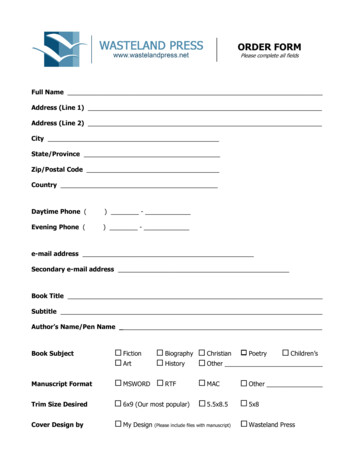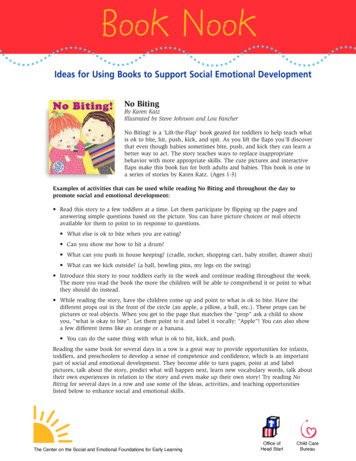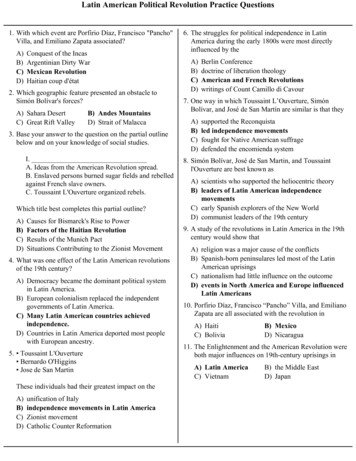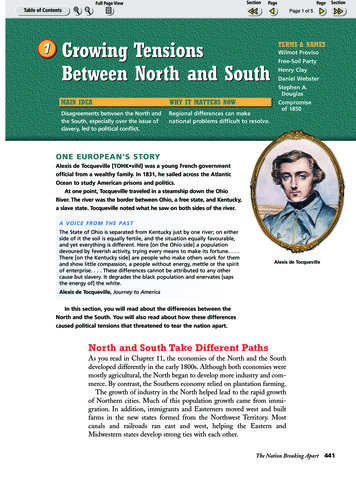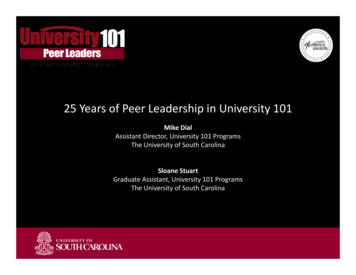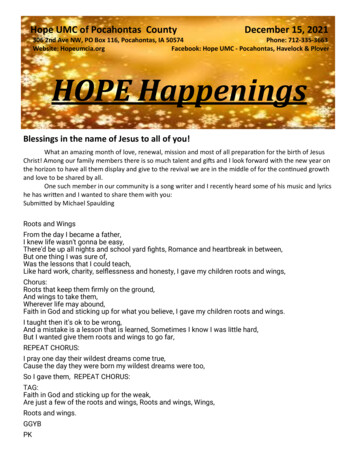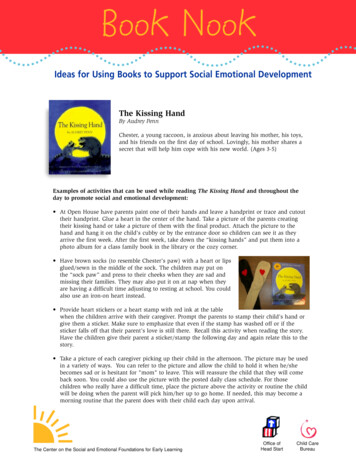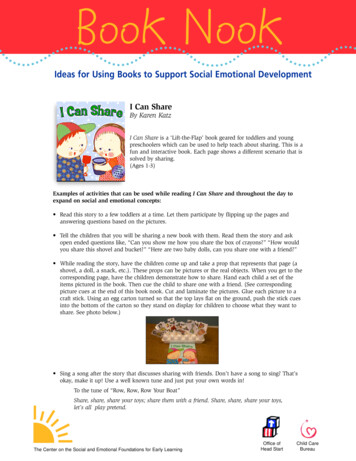
Transcription
Book NookIdeas for Using Books to Support Social Emotional DevelopmentI Can ShareBy Karen KatzI Can Share is a ‘Lift-the-Flap’ book geared for toddlers and youngpreschoolers which can be used to help teach about sharing. This is afun and interactive book. Each page shows a different scenario that issolved by sharing.(Ages 1-3)Examples of activities that can be used while reading I Can Share and throughout the day toexpand on social and emotional concepts: Read this story to a few toddlers at a time. Let them participate by flipping up the pages andanswering questions based on the pictures. Tell the children that you will be sharing a new book with them. Read them the story and askopen ended questions like, “Can you show me how you share the box of crayons?” “How wouldyou share this shovel and bucket?” “Here are two baby dolls, can you share one with a friend?” While reading the story, have the children come up and take a prop that represents that page (ashovel, a doll, a snack, etc.). These props can be pictures or the real objects. When you get to thecorresponding page, have the children demonstrate how to share. Hand each child a set of theitems pictured in the book. Then cue the child to share one with a friend. (See correspondingpicture cues at the end of this book nook. Cut and laminate the pictures. Glue each picture to acraft stick. Using an egg carton turned so that the top lays flat on the ground, push the stick cuesinto the bottom of the carton so they stand on display for children to choose what they want toshare. See photo below.) Sing a song after the story that discusses sharing with friends. Don’t have a song to sing? That’sokay, make it up! Use a well known tune and just put your own words in!To the tune of “Row, Row, Row Your Boat”Share, share, share your toys; share them with a friend. Share, share, share your toys,let’s all play pretend.The Center on the Social and Emotional Foundations for Early LearningOffice ofHead StartChild CareBureau
Book Nook Mash Potato Play Dough: Mix instant mash potatoes and cold water together to make play dough.Divide the dough into different bowls and use food coloring to make different colors. Place all thedifferent colors on one table. Let the children share the table space and colored potato dough.Reading the same book for several days in a row is a great way to provide opportunities for infants,toddlers, and preschoolers to develop a sense of competence and confidence, which is an important partof social and emotional development. They become able to turn pages, point at and label pictures, talkabout the story, predict what will happen next, learn new vocabulary words, talk about their ownexperiences in relation to the story and even make up their own story! Try reading I Can Share for severaldays in a row and use some of the ideas, activities, and teaching opportunities listed below to enhancesocial and emotional skills.SharingCircle:Share Box—Create a special share box that is only introduced during circle time. Decorate the box so it isattention grabbing: use colors like black, red, and white or one with a bold checker pattern. Inside thebox place items that can be shared like bubble with several wands, musical instruments, a baggie of goldfish crackers, a box of chunky sidewalk chalk, play dough, or several water-shakers.Be creative!Show and Tell—Have each child bring in a toy from home that they would like to share at school.Centers:Together We Share—In the mornings introduce side-by-side play. Have the children read books next toeach other or with each other. Let them know that they have to share the reading area, bean bag, or thebooks. Stay close by to support children as they try to practice sharing with each other.Reading Buddies—Create a fun and exciting reading area where the children can read their books. Haveeach child find a friend to sit with, let him/her know the different ways they can share the sitting area.You could bring in a hula-hoop for two children to sit in, a special rug, a child-size couch, or beachtowels. Make it different from the normal routine and try changing it up every once in a while.Blocks—Teach the children to share with friends by building blocks. Build a tower of blocks and haveone child push it down. Then build it again and allow a different child to push it over. Teach them to playtogether by building blocks and pushing them over. Teaching side-by-side play will help teach youngchildren the beginning steps of sharing. During block clean-up, all children can help by putting the blocksinto a bin or small laundry basket.House—Teach children how to share some of the toys in the kitchen area. Show them how to share thefood and the dishes while they are making ‘dinner’. (Note: There are great play food sets on the marketthat are cut in half and attached back together with Velcro. This would give toddlers the opportunity topractice “cutting” with a plastic knife and then sharing the food either with a peer or a baby doll.) Theycan share the responsibilities it takes to serve a great dinner. One can set the table, one can get thedrinks, one can cook the food, one can clean, etc. When finished pretending to eat, then they can sharethe cleaning responsibilities. Everyone puts away the items and then children work together, sharing thejob of cleaning the table with wet-wipes.Extension activity: Young children love water play, put soapy water in your housekeeping sink and allowthe children to use rags (teaching them to squeeze out the extra water) to clean the table.Outside Play:Bubbles—Play bubbles with a group of children. Let them know that you all will be playing bubblestogether. Have one big bubble bottle and give each child a bubble wand. They all share the bubble bottleby dipping in their individual wands to make bubbles in the air. Extension activity: Once children are ableto do the activity above, increase your expectations and begin teaching “turn-taking” with the bubbles.The teacher will hold the wand and the solution, one at a time let the children blow into the wand tomake bubbles. Keep commenting on how wonderful they are sharing the bubbles and taking turns. It isimportant to note that sharing is easier for young children than taking turns, due to the wait timeinvolved in turn taking.
Book NookPush/Pull Toys—Teach side-by-side play while children are playing outside with the push toys. Showthem that they can share the push toy by having one of them push and the other ride. Then have themswitch roles. They could also stand side-by-side and push the toy together.Water Play—Use one big water tub, something that allows all the toddlers to play in the water at thesame time. Use toys that promote playing together like water wheels, funnels, measuring cups, plasticcups and small buckets. Note: Sometimes it’s hard for toddlers to share the same activity. One way ofpreventing children from getting into another toddler’s space is to draw big squares on the sidewalk withchalk (or tape if inside the classroom) all around the water tub/table. Prompt the children that when atthe water area, they sit or stand in their personal square. If children begin to increase their skills withsharing items and space you can increase the size of the square to a rectangle and allow two children toshare the same space while they play.Art:Color—Use one long sheet of paper that everyone will color on. Then give each child a crayon, chalk,paint, etc. Let them know that they need to try to share the paper and the different colors.Paper Collage—Take different colored papers and cut it into small squares (not too small, keep your agegroup in mind). Mix non-toxic glue and water together in a small bowl. Place a large sheet of paper onthe table and have the children make a paper collage by dipping the squares into the glue solution andthen placing them on the long paper. You could have one child be in charge of painting the glue solutionon the paper.Colored Ice Cubes—Make ice cubes that are different colors by using food coloring. Use the frozen icecubes to draw on a long sheet of fabric (try old bed sheets), give each person a sheet to share with afriend. You can also try drawing a picture with a permanent marker and letting the children color it in!Golf Ball Can Art—Each child does this art project with a buddy. They each put their golf ball in a colorthey choose. Then they drop their two balls in a coffee can that has been lined with paper. The lid isplaced on and then they share in the activity by rolling the can back and forth to create a shared artproject. The paper is then taken out to dry and displayed on the wall.Extension activity: The teacher could take a photograph of the children doing their shared art projecttogether and then display the photo with their art work.Snack Time:Fruit Share—Serve fruit and have the children help you find a way to serve all the children with only 2apples. Show them how you can cut the fruit to share a bit of the apple with everyone. Other possiblefruits to share could be an orange, pear, or grapes.Extension activity: Have your children eat with dolls and see if they can pretend sharing some of theirfood with their dolls.Nap Time:Baby Doll Share Time—A great way to introduce sharing during nap is by allowing the children to takea doll to nap with them. Explain that they only have 1 blanket so the two of them (the child and thedoll) will have to share. Let them tuck the doll in and then you tuck them in.Good-Bye Time:Share the Day—Prompt your children to share what they did at school with their mommies and daddiesduring dismissal time. You can ask them to give their parents something that they made or cue them totell their parents what they did that day. You could also have them share photographs with their parentsdemonstrating how they share with their friends.This Book Nook was developed by Anne Taccetta and Rochelle Lentini
Printing: Print thesecolored as handouts with 2to a page.Boxes of Crayons? Cutting: Cut on dotted lineI can Share:3 Friends2 snacks1 shovel and 1 bucket2 bikes2 DollsI can Share:
Reading the same book for several days in a row is a great way to provide opportunities for infants, . social and emotional skills. Circle: . practice “cutting” with a plastic knife and then
